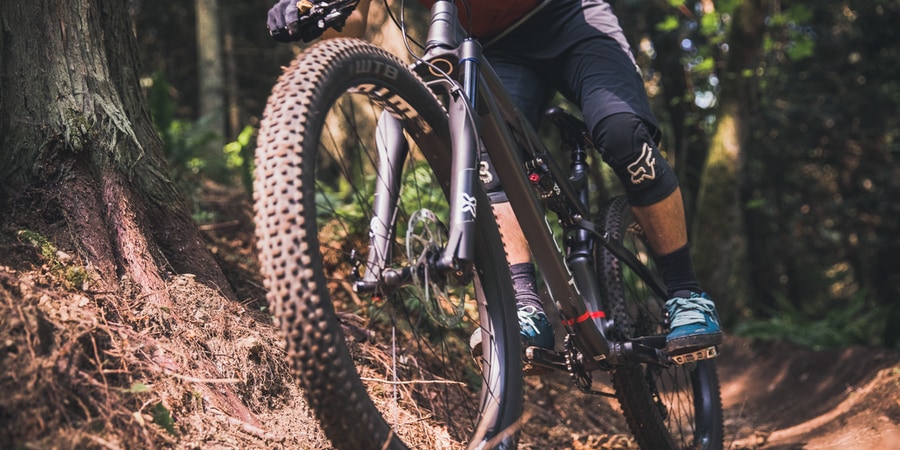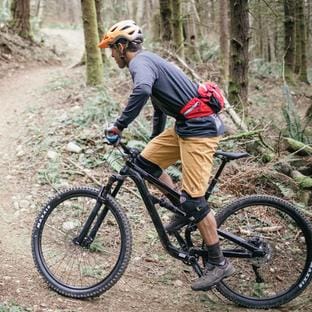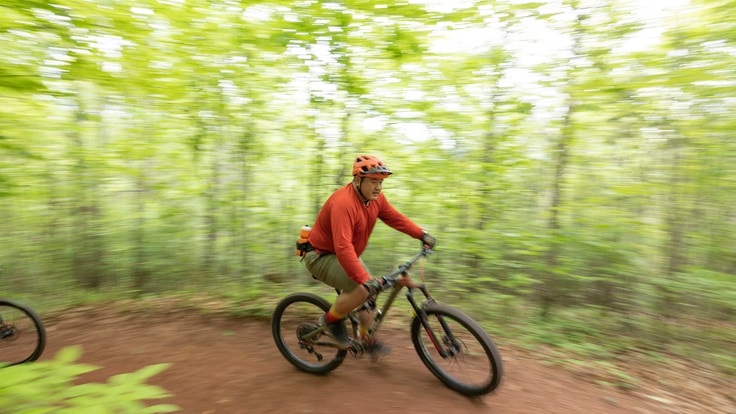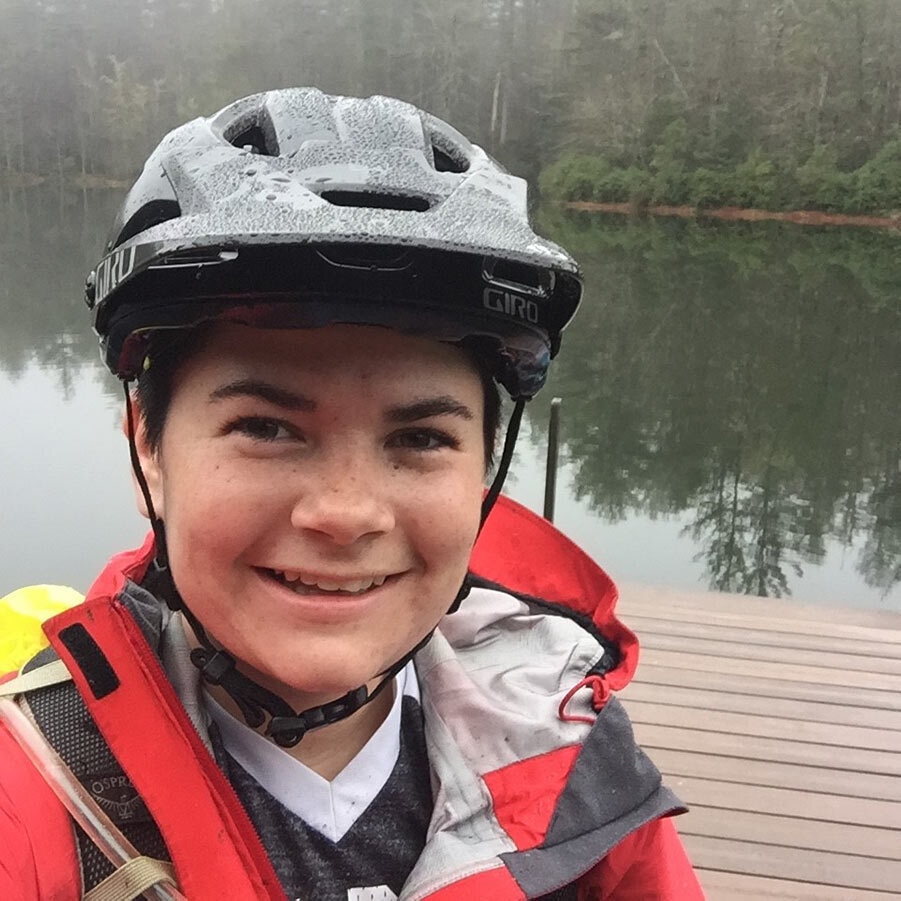Mountain biking is a fun outlet for exercise, adventure and time in nature. Pedaling a bike off-pavement takes you away from traffic and lets you explore the outdoors on dirt roads, scenic trails or other rugged terrain. Despite the name of the sport, you can mountain bike whether you live close to mountains or not. Routes can vary from smooth, mellow trails in the woods to high-adrenaline challenges on technical singletrack to sandy and scenic desert routes.
Ready to try? In this article, we'll cover the basics of what to expect before your first ride, including an overview of different types of mountain bike terrain, styles of mountain biking and basics for getting geared up for a fun time on the trails. Jump ahead for answers to the following questions:
- What are the different mountain biking styles?
- What mountain bike should you get?
- Where can you ride?
- What should you wear on a ride?
- What basic gear do you need to start mountain biking?
Take an Intro to Mountain Biking Class with REI
Mountain Biking Styles

Mountain bikes generally have the following characteristics:
- Fat tires with rugged tread for stability and durability when you venture off-road
- An upright and comfortable cycling position
- Suspension systems that absorb shock from bumps and trail features, like rocks and roots
Many bike manufacturers categorize their bikes based on the following styles of riding, to help you decide what type of bike is appropriate for you. But keep in mind that just because a bike is designed for a certain style of riding, it doesn't mean that is the only way it can be used.
Trail mountain biking: This is arguably the most common mountain biking style because the category isn't grounded in any specific type of racing. If you're interested in meeting up with friends at the local trailhead and riding a mixture of climbs and descents, then you're interested in trail riding. Trail mountain bikes place equal emphasis on fun, efficiency, downhill capability and sensible overall weight.
Cross-country mountain biking: This style of riding typically implies riding fast, with an emphasis on climbing prowess. Bikes tend to focus on light weight and efficiency, which makes them particularly well-suited for longer endurance rides, too. These bikes can be great if you're considering getting competitive or would like a racier ride for your local trails.
All-mountain/enduro mountain biking: Think of all-mountain/enduro riding as trail riding for those who climb up to ride down. This style of ride features bigger leg-burning climbs, longer white-knuckle descents, and more technical features—both man-made and natural. Bikes for all-mountain/enduro riding are designed to perform well on steep descents while also being light and nimble enough to pedal uphill.
The term enduro comes from the racing world and describes a competition that has timed downhill stages and untimed uphill stages. The winner is whoever has the fastest combined time on the downhills. Enduro riding has become very popular, and the term is now often used interchangeably with all-mountain regardless of whether you're racing or not.
Downhill/park mountain biking: This type of riding is mostly done at lift-serviced bike parks (often during a ski resort's warmer months). You ride big, tough bikes and wear full-face helmets and body armor. The bikes boast more durable components and fewer gears, and the suspension has more travel (the amount of movement in the suspension). All of this helps you conquer jumps, berms, rock gardens and wooden ramps. Given that you're descending the entire time, you don't have to pedal much, but you still get a serious workout because you're constantly reacting to the fast-approaching terrain.
Fat-tire biking: Picture the kind of bike you always wanted as a kid: one with giant tires that can roll through just about anything. Fat-tire bikes have tires that are at least 3.7 in. wide (and may be as wide as 5 in. or more). They offer excellent traction through snow and sand. Fat-tire biking is not limited to these conditions—some people also ride these bikes on trails. Fat-tire bikes can be a great choice for beginner mountain bikers because they are very forgiving on rough terrain.
What Mountain Bike Should You Get?

A mountain bike can be a huge investment so as you're starting, consider renting or test-riding mountain bikes before you buy. Bike shops often let you demo a bike before you buy for a fee, which you may be able to apply to purchase. Or find a local mountain bike festival or event where brands may provide bikes to demo. If you take an intro mountain biking class like one offered by REI, the class often provides bikes or allows you to rent one.
What type of bike you ride is usually decided by where you plan on riding. Suspension type and wheel diameter are two key features that determine what type of terrain the bike is capable of riding. You have a wealth of options when it comes to types of suspension and wheel diameter. We'll provide a basic overview below, but if you're shopping for a mountain bike, read our in-depth guide on how to choose a mountain bike for more details on the types of bikes available and what features to look for.
Suspension Type
The main function of suspension is to keep the wheels of the bike on the ground, maximizing control for the rider. (Learn more in our article, Mountain Bike Suspension Basics).
Rigid mountain bikes: These mountain bikes don't feature any suspension. They're easy to maintain and usually less expensive, but most riders prefer bikes with suspension for greater comfort. One exception: Most fat-tire bikes are rigid, and riders find that the wide tires and low tire pressure provide all the squish needed to absorb bumps in the trail.
Hardtail mountain bikes: These bikes have a suspension fork in the front to help absorb impact on the front wheel, but the rear of the bike has no suspension—ergo a hardtail. Hardtails are typically less expensive than full-suspension bikes, and have fewer moving parts, which often translates to less maintenance. The lower cost and easier maintenance make them a solid option for everything except serious lift-serviced downhill trails.
Full-suspension mountain bikes: There are many variations of full-suspension bikes, but the general idea is for the front fork and rear shock to absorb the impacts of the trail. This drastically reduces the impact on the rider, increases traction, and makes for a more forgiving and enjoyable ride. A full-suspension bike can soak up a lot of trail bumps and chatter, but the bike can also "bob" a bit and you lose some of the energy transfer when climbing uphill. As a result, most full-suspension rigs can lock-out the rear suspension to offer better power transfer and more efficient climbing.
Wheel Size
26 in.: In the not too-distant past, all mountain bikes were equipped with 26 in. wheels. It is still a popular wheel size for its responsiveness and maneuverability, but now when you walk into a bike shop and inquire about mountain bikes, you are likely to be asked, "26 in., 27.5 in. or 29 in.?"
27.5 in. (650b): Offering a middle ground between standard 26 in. wheels and 29ers, these bikes apply a "best of both worlds" solution, more easily rolling over terrain than the 26s but more maneuverable than the 29er. As with 29ers, this wheel size can be found on both full-suspension and hardtail rigs.
27.5+ in.: The plus symbol simply indicates extra-wide wheels and tires, typically 2.8 in. or more in width. Wider tires offer a more comfortable and more forgiving ride. They also encounter less rolling resistance.
29ers: Bike featuring 29 in. wheels that are typically heavier and a little slower to accelerate, but once you start moving you can conquer considerably more terrain more easily than on a bike with standard 26 in. wheels. They generally offer excellent grip and they have a higher "attack angle"—meaning the wheel rolls over trail obstacles more easily. These bikes have become extremely popular for the cross-country crowd. 29ers can be found in both hardtail and full-suspension rigs.
Where to Ride Your Mountain Bike
Mountain-bike-specific trails are typically marked by skill level (beginner, intermediate, expert and double expert) and are maintained. While you might start out on beginner-friendly trails that are relatively smooth and flat, your ability to navigate around or over obstacles will develop as you gain experience. Eventually, this challenge becomes a part of the fun of the sport.
You may have heard mountain bike riders refer to riding singletrack and doubletrack trails. What's the difference between the two?

Singletrack, the most common type of mountain bike trail, is narrow, about the width of your shoulders. Riders generally travel in single file on singletrack, which has just enough room for two bikes to pass. Many singletrack trails are open to one-way travel and wind their way through the best terrain that the landscape offers.
Doubletrack trails are normally double the width (or more) of a typical singletrack trail with enough room for two bikes to ride side-by-side. Often doubletrack trails follow abandoned logging roads, fire roads or power-line roads, where the tires of vehicles created two tracks. Doubletrack trails tend to have fewer technical features than singletrack.
Mountain bike skills parks are popping up everywhere from jump-and-pump tracks under urban overpasses to lift-serviced trails at ski resorts. These parks are often easily accessible, located in or near metropolitan areas, and are great places for beginners and other riders to hone their skills. Expect such features as elevated bridges, halfpipes, jumps of various sizes, berms, banked corners and downhill switchbacks.
Where can you ride? There are lots of resources to find places to mountain bike. You can find trails through crowdsourced databases such as Trailforks or MTB Project. Consider joining a local or regional mountain bike club like the Southern Off-Road Bicycle Association, the Mid-Atlantic Off-Road Enthusiasts or Evergreen Mountain Bike Alliance in the Pacific Northwest, to name a few. These clubs often build and maintain trails, and provide trail maps with difficulty ratings. Find a club near you by using the MTB Project's directory of mountain bike clubs in the U.S.
Trail Difficulty Rating System
Mountain bike trails are graded according to skill level, similar to the trail system used at ski areas. The following descriptions are based on the International Mountain Bike Association (IMBA) guidelines, but trails are generally rated according to the judgment of local riders or advocacy groups, so ratings may vary from one place to another.
- Beginner trails, often symbolized by a green circle, are generally smooth. They usually average no more than a 5% trail grade, don't exceed 15, and feature trail obstacles that are no taller than a couple of inches.
- Intermediate trails, symbolized by a blue square, are variable in their surface. They usually average a 10% grade or less, (though some may exceed a 15% grade), and feature unavoidable obstacles up to eight inches tall.
- Advanced trails, often marked by a black diamond, may have many trail features, and can average up to a 15% grade, with steep sections. Unavoidable obstacles can be up to 15 inches tall, and there may be man-made features, too.
- Expert trails, often denoted by double-black diamonds, are highly variable and may be unpredictable. They may be very steep—15% or greater—and feature unavoidable obstacles that are taller than 15 inches, loose rocks, and have many technical features (both natural and man-made). These trails are for the most experienced riders only.
What to Wear Mountain Biking

Bike-specific clothing makes for a more comfortable ride, no matter what style of biking you're doing. That said, different styles of mountain biking will dictate what type of clothing and protective gear you'll choose.
Mountain bike shorts: Some mountain bikers, especially cross-country racers, wear form-fitting Lycra shorts that have a padded chamois, which helps to reduce saddle fatigue. Trail riders generally wear baggy styles over padded shorts. These overshorts have more of a casual look, and more importantly, they provide some abrasion protection in the instance of crashes. Many overshorts will also include an inner liner short with a chamois.
Mountain bike jerseys and shirts: Similar to shorts, jerseys range from form-fitting zip-up styles with pockets to loose T-shirt style jerseys that are more casual-looking. Regardless of fit, you still want to choose something that wicks sweat and dries quickly. You'll also want something you can wash and dry with little fuss. If you plan to carry a pack, you won't need a jersey with lots of pockets.
Mountain bike gloves: Most mountain bikers ride with gloves because they help maintain grip on the handlebar when the hands get sweaty and reduce friction that can cause blisters. Full-fingered gloves also keep your hands warmer and add protection in the event of a crash. Some gloves have an extra layer of protective padding on the palms and over the hands and fingers.
Learn more in our article, What to Wear Mountain Biking.
Mountain Bike Gear and Accessories
Mountain Bike Helmets: Mountain bike helmets typically offer more coverage and protection than road bike helmets. Look for one with plenty of venting and protection at the lower back of the head. For downhill riding, consider a full-face helmet; most bike parks rent those models.
Regardless of style, all models on the market have to pass rigorous safety tests. Some helmets now feature the new Mips technology, a low-friction layer that slides independently of the outer shell and limits the rotational forces to the brain when the helmet gets hit at an angle. Learn more in Bike Helmets: How to Choose and The Best Bike Helmets: Staff Picks.
Mountain Bike Shoes and Pedals
The right shoe/pedal combination depends on your comfort level and what type of riding you're planning on doing. For all styles of riding, choose shoes that have hard protective toes, some decent grip for when you have to hike, and some water protection for rain and mud.
Flat mountain bike pedals: Beginners and people less confident on mountain bikes can benefit from starting with flat platform pedals (which don't have a cleat system) so you can get on and off the bike and put your foot down quickly without having to unclip from the pedal. This is a good way to build technique, and makes the transition to clipless pedals much smoother.
Clipless mountain bike pedals: As your skills progress, you can go with either clipless pedals and compatible shoes, or stick with platform pedals. Clipless pedals (which despite the name, actually attach to your shoes using a cleat system) deliver a lot more control and power transfer, but also demand more commitment in tricky terrain. When learning to ride with clipless pedals, give yourself plenty of practice time on soft grassy terrain to get used to connecting and disconnecting your foot from the pedal.
For all styles of riding, choose shoes that have hard, protective toes, some decent grip for when you have to hike and some water protection for rain and mud.
For more information, see Bike Pedals: How to Choose and Use and Bike Shoes: How to Choose.
Hydration Packs
Hydration packs are too bulky for road bikers, but their convenience makes them ideal for mountain biking. Go with a mountain bike pack that has sufficient storage space for an extra clothing layer, repair essentials and snacks, and a clip to secure your hydration sleeve to the shoulder or sternum strap of the pack.
Mountain Bike Repair Kit Essentials
Save yourself a lot of hassle—and walking—by packing a few in-the-field mechanical items: a spare tube, a hand pump or CO2 inflator, and a small multitool with several Allen wrenches and a chain tool.




